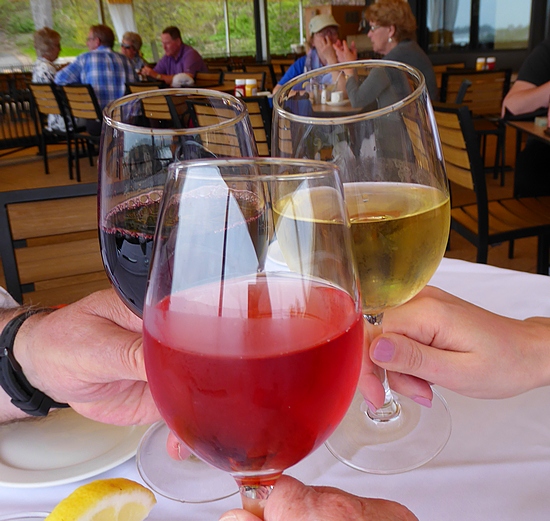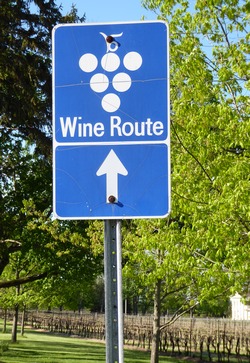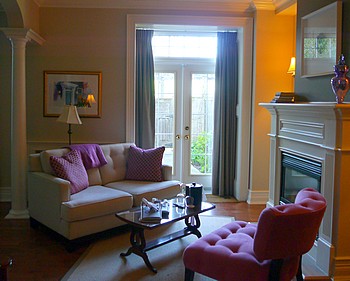
We went for the wine, but we stayed for the food. Serious winemaking with vinifera grapes began in the Niagara Peninsula in 1975. When we last visited about 15 years ago, Niagara icewines were world class and table wines were making tremendous strides. An Ontario wine dinner in Toronto last fall (hungrytravelers.com/ontario-wine-country-becomes-world-player) convinced us that Niagara has matured as an important producer of good wines. So in late May we packed up the car and drove across Massachusetts and upstate New York. We spent a week exploring this bucolic peninsula that sits about an hour’s drive east of Toronto.

Most of the wineries lie in a band of soils and climatic conditions between the limestone ridge of the Niagara escarpment and the south shore of Lake Ontario. As the map above shows, the main communities in this region are (from west to east) Lincoln, Beamsville, Vineland, St. Catherine’s, Niagara-on-the-Lake, and St. David’s. (You can download a full version at mtc.gov.on.ca/images/regions_maps/Region02.pdf.) The fertile wine country barely extends more than a dozen miles south of the lake. The great tourist destination of Niagara Falls lies a few miles farther south.
 Blue roadside markers with a stylized cluster of grapes seem to beckon: “This way to the wine!” If there were any doubt, they’re labeled “Wine Route.” Come to a crossroads in wine country, and the signs may not tell you the name of the road. But they will tell you which wineries are somewhere along the route. According to the Vintner’s Quality Alliance of Ontario (vqaontario.ca), more than 90 wineries fall within the Niagara Peninsula appellation. Most of them encourage visitors.
Blue roadside markers with a stylized cluster of grapes seem to beckon: “This way to the wine!” If there were any doubt, they’re labeled “Wine Route.” Come to a crossroads in wine country, and the signs may not tell you the name of the road. But they will tell you which wineries are somewhere along the route. According to the Vintner’s Quality Alliance of Ontario (vqaontario.ca), more than 90 wineries fall within the Niagara Peninsula appellation. Most of them encourage visitors.
Tasting and grazing through Niagara
The rural area is so compact that you can pick a base anywhere and drive everywhere else. We spent our time partly based at Inn on the Twenty (innonthetwenty.com) (right). 
It’s in Jordan Station, a village of Lincoln. We spent another segment at the swanky Prince of Wales Hotel (vintage-hotels.com/princeofwales) in Niagara-on-the-Lake. And, we must admit, we also visited Niagara Falls because, well, it is one of the seven wonders of the world. And the Canadian side is one fabulous linear park on the high embankment. For full details on lodging and information on other attractions, see visitniagaracanada.com.
 The eating is usually good in wine country throughout the world. It’s better than good in Niagara. This region is so rooted in agriculture that we wondered if some locals possess the DNA for chlorophyll production. From farmers to chefs to servers, Niagara folk have a profound appreciation for the gifts of the earth. Chefs fully embrace the trend toward local sourcing, and some of them go a step or more beyond. At the best restaurants, dining is so purely local that it’s almost like eating on the farm. A few places, in fact, are surrounded by fields, fruit trees, and grapevines—as this whimsical 2011 Fork in the Road by Floyd Elzinga attests. It sits at the edge of a vineyard at the Good Earth Food & Wine Company (goodearthfoodandwine.com) as you enter the wine shop and bistro.
The eating is usually good in wine country throughout the world. It’s better than good in Niagara. This region is so rooted in agriculture that we wondered if some locals possess the DNA for chlorophyll production. From farmers to chefs to servers, Niagara folk have a profound appreciation for the gifts of the earth. Chefs fully embrace the trend toward local sourcing, and some of them go a step or more beyond. At the best restaurants, dining is so purely local that it’s almost like eating on the farm. A few places, in fact, are surrounded by fields, fruit trees, and grapevines—as this whimsical 2011 Fork in the Road by Floyd Elzinga attests. It sits at the edge of a vineyard at the Good Earth Food & Wine Company (goodearthfoodandwine.com) as you enter the wine shop and bistro.
Just as Niagara vineyards have perfected the art of making cold-climate wines (citrusy Chardonnay, berry-licious Gamay, red-pepper ripe Cabernet Franc, and honeyed Riesling), the chefs welcome the challenges of indigenous cold-climate cuisine. Despite global warming, periodic visits by the polar vortex keep Niagara honest. The food speaks of the lower Rhone valley in summer, but it shares more with Copenhagen and Dublin the rest of the year.
Watch this space for details.
